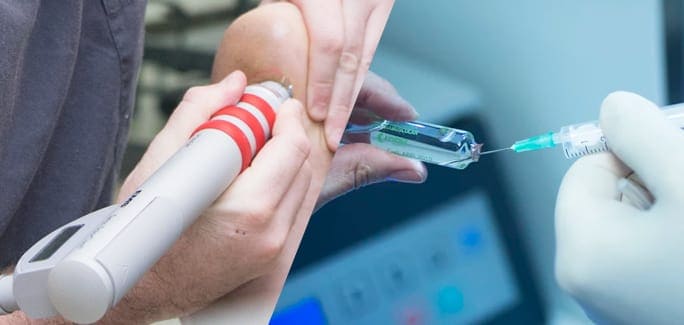Injury to the Achilles tendon is one of the most common athletic injuries, and it is no wonder, given the intense force loads the Achilles is subjected to during running and jumping. Achilles tendinopathy presents as pain, swelling and impaired function. With tendinopathy, damage to the tendon tissue is more serious than tendinitis, which is simply inflammation.
Under the umbrella of Achilles tendinopathy are distinct subcategories of injury:
- Acute tendinopathy results from a specific sudden incident, such as an injury incurred on the athletic playing field.
- Chronic tendinopathy is a condition that gradually worsens over time, typically from repetitive use, poor ankle flexibility, and neglect.
- Insertional tendinopathy manifests at the enthesis of the tendon where it attaches to the calcaneus, or heel bone.
- Mid-portion tendinopathy affects the mid portion of the Achilles a few centimeters above the calcaneus.
The nature and onset of the injury influences the rate of healing and the choice of treatment.
Conservative treatment for Achilles teninopathy is normally effective in promoting healing and restoring function to the Achilles tendon. Eccentric loading, where workload is emphasized as the calf muscles and Achilles tendon lengthen, is universally accepted as an effective approach to treatment.
However, technology and research are continually unveiling new approaches to treatment, to be either rejected or embraced by the medical community.
Two of the more recent and advanced modes of treatment are ESWT (extracorporeal shock wave therapy) and platelet rich plasma (PRP) injections, and each has been shown to be effective in promoting recovery from Achilles tendinopathy. However, there is some controversy about the overall effectiveness of these treatments compared to conservative eccentric loading, and about whether one treatment is more effective than the other.
- Platelet Rich Plasma Injections: In PRP treatment, a portion of the patient’s own blood with a high concentration of platelets and different growth factors is injected into the injury site to stimulate healing of bone and soft tissue.
- Extracorporeal Shock Wave Therapy: ESWT transmits an intense short energy wave through a sound head, similar to ultrasound, to increase the healing potential of injured tissues.
A number of studies have been conducted comparing the two treatment methods, along with eccentric loading, with varying and often conflicting outcomes.
- In a 2008 study of 50 patients with chronic insertional tendinopathy, Rompe et al. found ESWT to be more effective than eccentric exercise after four weeks, with 64 percent of the ESWT patients able to return to daily activities compared to only 28 percent of the eccentric group.
- A 2010 randomized controlled study of 54 patients with chronic Achilles tendinopathy compared eccentric exercise to PRP or saline injection. Results showed no differences in pain and activity levels among the groups at a six-month follow-up.
- A 2013 meta-analysis by Sadoghi et al. found PRP to be beneficial in increasing tendon healing strength in acute Achilles tendon ruptures, but the authors found no benefits of PRP in treating chronic Achilles tendinopathy.
However, a recent study by Erroi et al. (2017) concluded,
“Both ESWT and PRP therapy are effective and safe. Our study confirms the success of these conservative treatments in Achilles tendinopathy, even in the insertional one.”
In most cases, a physical therapist will take a multi-modal approach to treatment of Achilles tendinopathy, employing some combination of eccentric loading, manual therapy, ESWT and PRP.
The sports medicine specialists at NYDNRehab use cutting edge therapies and treatments for Achilles tendinopathy, employing the most up-to-date technological innovations in patient care. If you suffer from pain and dysfunction in your Achilles tendon, contact NYDNRehab today and let us put you on the road to speedy recovery.
Resources
De Vos RJ, et al. Platelet-rich plasma injection for chronic Achilles tendinopathy: a randomized controlled trial. J Am Med Assoc. 2010;303(2):144–149.
Rompe JD, et al. Eccentric loading compared with shock wave treatment for chronic insertional Achilles tendinopathy. J Bone Joint Surg. 2008;90(1):52-61.
Sadoghi P, Rosso C, Valderrabano V, Leithner A, Vavken P. The role of platelets in the treatment of Achilles tendon injuries. J Orthop Res. 2013;31(1):111–118.























































